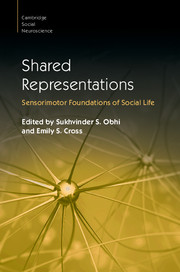Book contents
- Shared Representations
- Cambridge Social Neuroscience
- Shared Representations
- Copyright page
- Contents
- Figures
- Tables
- Boxes
- Contributors
- Preface
- Part I Foundations
- Part II Imitation and Mimicry
- Part III Thinking, Perceiving and Acting with Others
- Part IV Understanding Others
- Part V Learning and Development
- Part VI Shared Representations in Applied Contexts
- 27 Sport Performance
- 28 Shared Mental Models in Sport and Refereeing
- 29 Musical Synchronization, Social Interaction and the Brain
- 30 You Move, I Watch, It Matters
- Index
- Plate Section (PDF Only)
- References
29 - Musical Synchronization, Social Interaction and the Brain
from Part VI - Shared Representations in Applied Contexts
Published online by Cambridge University Press: 27 October 2016
- Shared Representations
- Cambridge Social Neuroscience
- Shared Representations
- Copyright page
- Contents
- Figures
- Tables
- Boxes
- Contributors
- Preface
- Part I Foundations
- Part II Imitation and Mimicry
- Part III Thinking, Perceiving and Acting with Others
- Part IV Understanding Others
- Part V Learning and Development
- Part VI Shared Representations in Applied Contexts
- 27 Sport Performance
- 28 Shared Mental Models in Sport and Refereeing
- 29 Musical Synchronization, Social Interaction and the Brain
- 30 You Move, I Watch, It Matters
- Index
- Plate Section (PDF Only)
- References
Summary
Music production and perception and human social understanding are linked in many ways. Producing and enjoying music appears unique to humans, and debate surrounds the topic of music’s function, especially in relation to its evolutionary origins. Here, we discuss links between music and sociality, and how insights from the unique fields of music neuroscience and social neuroscience can be combined to understand this relationship.
- Type
- Chapter
- Information
- Shared RepresentationsSensorimotor Foundations of Social Life, pp. 603 - 626Publisher: Cambridge University PressPrint publication year: 2016
References
- 1
- Cited by



